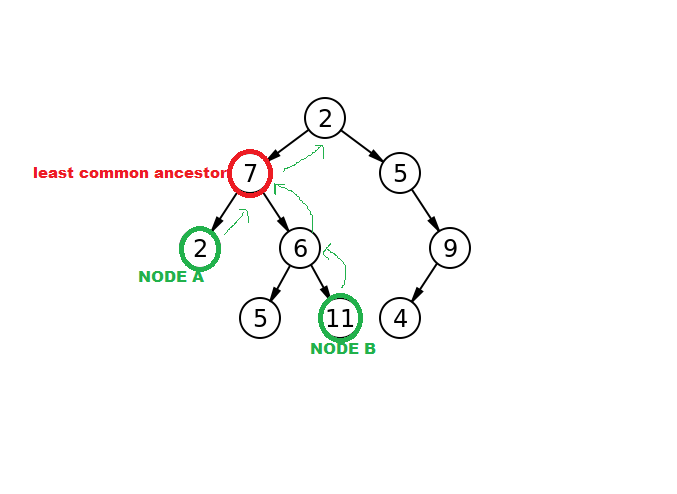Finding LCA using Binary Lifting
Let be a tree. For every query of the form (u, v) we want to find the lowest common ancestor of the nodes u and v, i.e. we want to find a node w that lies on the path from u to the root node, that lies on the path from v to the root node, and if there are multiple nodes we pick the one that is farthest away from the root node. In other words the desired node w is the lowest ancestor of u and v. In particular if u is an ancestor of v, then u is their lowest common ancestor.
To calculate the LCA of two nodes first we will bring both the nodes to the same height by making the node with greater depth jump one parent up the tree till both the nodes are at the same height. Once, both the nodes are at the same height we can then start jumping one parent up for both the nodes simultaneously till both the nodes become equal and that node will be the LCA of the two originally given nodes.
Consider the below n-ary Tree with depth 9 and let’s examine how the naive approach works for this sample tree.
Here in the above Tree we need to calculate the LCA of node 6 and node 30.
Clearly, node 30 has greater depth than node 6. So first of all we start jumping one parent above for node 30 till we reach the depth value of node 6 i.e. at depth 2.
The blue color path in the above figure shows the jumping route for both the nodes
The orange colored path in the above figure demonstrates the jumping sequence to reach depth 2. In this procedure, we just simply jump one parent above the current node.
Now both nodes are at the same depth 2.Therefore, now both the nodes will jump one parent up till both the nodes become equal. This end node at which both the nodes become equal for the first time is our LCA.
Time Complexity: We pre-calculate the depth for each node using one DFS traversal in O(n). Now in the worst case, the two nodes will be two bottom-most nodes on the tree in different child branches of the root node. Therefore, in this case, the root will be the LCA of both the nodes. Hence, both the nodes will have to jump exactly h height above, where h is the height of the tree. So, to answer each LCA query Time Complexity will be O(h). If the tree is queried q times then the overall time complexity will be O(qh) that will almost be the order of O(n^2), which isn't very efficient.
So, now we move on to the efficient approach using the Binary Lifting Technique. The technique is based on the fact that every decimal number can be converted into a binary number, so instead of making n jumps to get to the nth parent of a particular node, we can make log n jumps instead. How we do it is explained below:
For each node we will precompute its ancestor above him, its ancestor two nodes above, its ancestor four above, etc. Let's store them in the array up, i.e. up[i][j] is the 2^j-th ancestor above the node i with i=1...N, j=0...ceil(log(N)). These information allow us to jump from any node to any ancestor above it in O(log N) time. We can compute this array using a DFS traversal of the tree.
For each node we will also remember the time of the first visit of this node (i.e. the time when the DFS discovers the node), and the time when we left it (i.e. after we visited all children and exit the DFS function). We can use this information to determine in constant time if a node is an ancestor of another node.
Suppose now we received a query (u, v). We can immediately check whether one node is the ancestor of the other. In this case this node is already the LCA. If u is not the ancestor of v, and v not the ancestor of u, we climb the ancestors of u until we find the highest (i.e. closest to the root) node, which is not an ancestor of v (i.e. a node x, such that x is not an ancestor of v, but up[x][0] is). We can find this node x in O(log N) time using the array up.
We will describe this process in more detail. Let L = ceil(log(N)). Suppose first that i = L. If up[u][i] is not an ancestor of v, then we can assign u = up[u][i] and decrement i. If up[u][i] is an ancestor, then we just decrement i. Clearly after doing this for all non-negative i the node u will be the desired node - i.e. u is still not an ancestor of v, but up[u][0] is.
Now, obviously, the answer to LCA will be up[u][0] - i.e., the smallest node among the ancestors of the node u, which is also an ancestor of v.
So answering a LCA query will iterate i from ceil(log(N)) to 0 and checks in each iteration if one node is the ancestor of the other. Consequently each query can be answered in O(log N).
References: GFG and CP Algorithms
Thanks for reading! Do have a look at other posts for more content.
_______________________________________________________________


Lovely Article.Very neat and Informative for revision and learning purpose
ReplyDelete